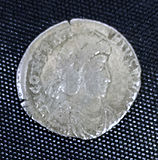This week’s quiz made reference to Sir Isaac Newton’s turn as a badass counterfeit-buster. And oh yes it’s true, let’s find out a little about what happened.
We know Newton as a lazy man who lounged under apple trees, but did you know that he also did pioneering work in physics and mathematics? And that he was maybe one of the most influential human beings ever to have lived? Well he was, but sadly enough, coming up with amazing, world changing ideas doesn’t necessarily pay the bills. It’s infuriating to imagine, but Newton hadn’t really capitalized on his achievements financially, and so his pals did their best to find him some kind of patronage post. Eventually they succeeded, with an appointment to the positions of Warden of the Royal Mint and Master of the Mint in 1696. Yes, he had the freshest breath in all the British Isles. These posts were intended to be mostly ceremonial, but Newton evidently took them seriously and got rather into the job. I guess this is the perfect two headed coin of Western Civilization: it can produce a towering figure like Newton and push his ideas to the utmost, and at the same time it forces such a man to become a bureaucrat in order to survive.
At the time England was beset with monetary woes, and upon Newton’s appointment he undertook a plan to re-mint literally every coin in the nation. They had a couple of big problems. First, English coins were worth less, in terms of their face value, than the value of the silver within them in certain European markets. So you could gather up some coins in Staines, head over to Amsterdam, and profit. That’s not a good scenario. Second, for years people had been “clipping coins”. It’s pretty much what it sounds like, you take off little bits of the edge of the coin, such that it’s still usable, but eventually you’ll have enough precious metal to either forge your own coins or sell it as bullion.
These are examples of coin clipping from the Roman Empire. I love the ancient world for stuff like this; Asterix and Obelix got a little greedy with that last coin. It’s half gone! I used to think that this was just the result of natural erosion through use, but of course it’s not. Ever wonder why coins have ridges on their edges? Originally it was to prevent clipping. Another interesting method was called “sweating”. You put a bunch of coins in a bag and shake the hell out of it. Then you collect the tiny filings from the bottom of the bag. Every time you think you have it rough just remember that somewhere in 17th Century England lived some poor sucker who shook bags of coins furiously to afford food.
The third problem facing England’s currency at the time was counterfeiting. Something like 10% of English currency at the time was fake. I’m no economist and I don’t feel like doing the research, but I wonder if this wasn’t actually a positive feature, since so much coinage was leaving circulation to foreign markets. Markets Abhor a Vacuum: the Positive Effect of Counterfeiting in 17th Century England. Hey, free PhD. thesis topic for you!
Regardless, Newton cracked down on counterfeiting with great success, and undertook prosecutions of many scammers. The penalty for this crime, considered treason, was death, so it may be that Newton had the greatest personal body count of any mathematician since Archimedes (who supposedly invented a Death Ray made of mirrors used to set enemy ships on fire). But what is Holmes without Moriarty? Meet criminal extraordinaire William Chaloner.
There appears to be no surviving likeness of Chaloner, so let’s just pretend that he looked like this. Yes I know it’s the wrong era. Chaloner was born in the 1650s and was an amazingly prolific criminal. He was an expert forger, creating fake coins, fake bank notes, and even fake lottery tickets. I admit to having a soft spot for forgers because many of them really do have true skill. A shame it couldn’t be put to better ends. Chaloner wasn’t just a forger though, oh no. He also employed what a contemporary called “tongue-pudding” as a quack doctor, and soothsayer. He would tell “silly wenches” what sorts of husbands they would have, and would help people to discover their stolen property, which of course he himself had stolen. Not a bad little racket.
He also manufactured dildos for a while, which were cleverly concealed inside of… watches. That’s what the sources say, I can’t really picture it, but man this guy was enterprising. Here’s a lengthy blog article about pre-modern dildos, if you’re interested. And finally, he worked another lucrative scam. This period was the time of the Jacobite uprisings and rebellions. I admit to lazily thinking that the English Jacobites had something to do with the later French Jacobins. Sounds similar, right? Wrong. The Jacobites took their name from the Latin name Jacobus, or James, and originated with English King James II (who was also King of Scotland). Super quick version: James was a Catholic who was ultimately deposed in the Glorious Revolution for proposing tolerance of Catholics amongst other things. He fled to France, and various intrigues and counter revolutions followed. Ultimately, this process led to the extinction of the House of Stuart (the tomb of the last members is pictured below). ed. note: if you like Game of Thrones you will probably enjoy European history from around this era; it’s insane. Especially the Wars of the Roses.

Jacobites were persona non grata back then so Chaloner made a tidy business of entrapping them. He would get involved in Jacobite plots and then sell out his unwitting co-conspirators and collect a sizeable reward. He made £1000 in one case, which is worth something like a hundred times that amount today. A pretty good scam!
Chaloner got busted numerous times, but he would always name names to save his own skin and get away scot free. I have no idea why any other crooks would continue working with him, and it just goes to show that we should be thankful that criminals are typically as dumb as they are.
Not content with manufacturing sex toys, living like a gentleman, abandoning his family, hanging out with various mistresses, and sending political opponents of the regime to their deaths, Chaloner just had to poke the bear. In a plot befitting a modern comic book super villain, he – the nation’s premier forger – actually complained to the Privy Council that the Royal Mint (including Newton) was corrupt, and making minting tools available to forgers (i.e. himself). His proposed solution? Why, that Chaloner himself should be allowed to inspect the Mint and conduct an investigation. Hilariously he even named the names of various forgers in league with corrupt officers within the Mint, including a “Mr. Chandler” which was, in fact, his own alias.
Newton ran into Chaloner at Parliament one day and had him arrested in connection with an older forgery case, but Chaloner managed to pay the key witness against him to disappear to Scotland and the case collapsed. Chaloner was free again, after a seven week stint in the slammer. But Newton was officially pissed and decided to strike back.

Sir Isaac undertook a personal campaign to get revenge on Chaloner. He went around leaning on witnesses, threatening people, gathering evidence, and finally had what he needed. By my scant reading it appears that Newton put together a pretty flimsy case based on two particular forging scams (of which Chaloner was no doubt guilty), and managed to get it tried by a hanging judge in a court that maybe didn’t even have jurisdiction to try the case. But hey, he invented gravity, right? So cut him some slack. At first Chaloner pretended to be insane, and when that didn’t work he resorted to abusing members of the court, all to no avail. Chaloner was found guilty and sentenced to death.

While waiting for the hangman’s noose he wrote numerous letters to Newton himself begging for mercy. Here’s an excerpt:
nobody can save me but you O God my God I shall be murdered unless you save me O I hope God will move your heart with mercy pitty to do this thing for me I am Your near murdered humble Servant
But Newton never bother to respond and offered Chaloner a final insult by refusing to attended his execution. Chaloner was hanged, and drawn and quartered. Newton then burned all the paperwork associated with the case.
Enjoy these tales? Come on out and play the weekly pub trivia game. It’s fun and free, and full of stuff like this.
Further reading
The later life of Isaac Newton
Random wiki thing: list of notable executions at Tyburn, where our man met his end





This is a fascinating tale of crime and intrigue. Well done. This must have taken some serious time to research
LikeLike
The way he gathered that evidence, too, would make Jack Bauer look like an ACLU lawyer.
LikeLike
My curiosity piqued, I read the following on Wikipedia:
“Newton had himself made a justice of the peace in all the home counties”
and
“Then he conducted more than 100 cross-examinations of witnesses, informers, and suspects between June 1698 and Christmas 1699. Newton successfully prosecuted 28 coiners”
If you want it done right, do it yourself?
LikeLike
hahahaha, seriously man. He did not mess around, nor trust subordinates, evidently.
LikeLike
Pretty good summary. I’m part of an amateur group performing a dramatisation of this next week in Newton’s old school in Grantham, Lincolnshire. I’m Chaloner 🙂
LikeLike
Now that is cool!! Break a leg, good sir! Man the Internet is awesome sometimes, eh?
LikeLiked by 1 person
Thanks! 🙂
Here’s a bit more blurb on what we’re doing (I’m in the black cloak in the pic). http://www.granthammatters.co.uk/events/the-old-dogg-at-the-mint2/
It was great reading your piece on Newton’s time at the Mint – we’re so wrapped up in the performance element we tend to forget it was a real event and that other people know about it!
LikeLike